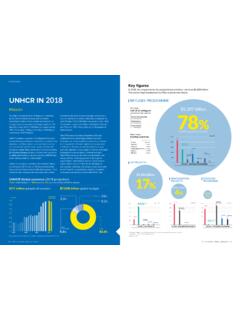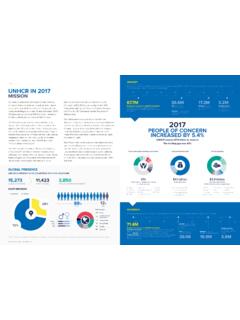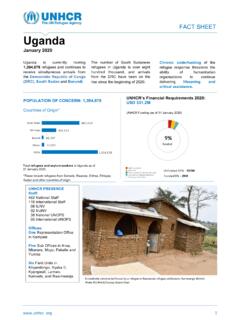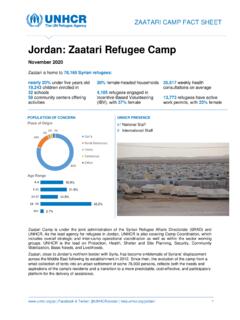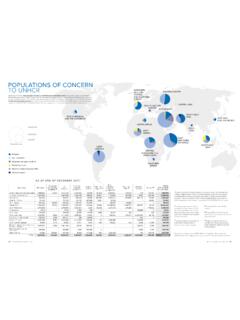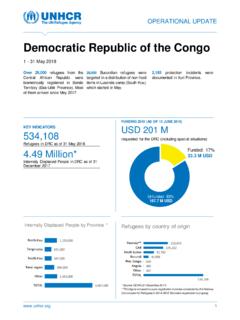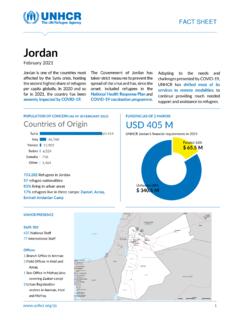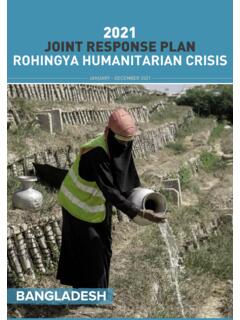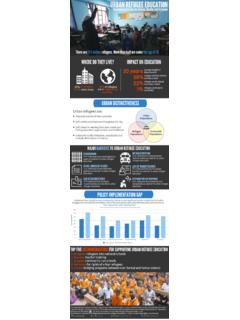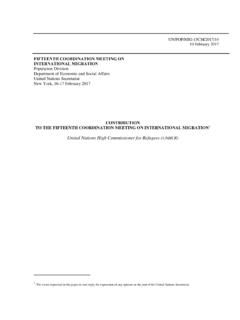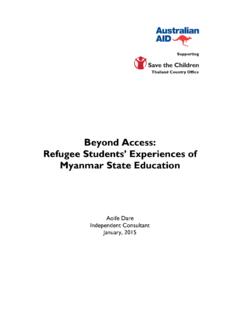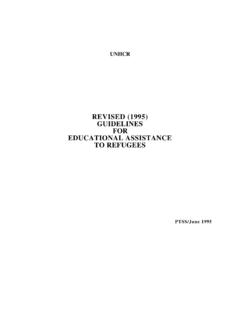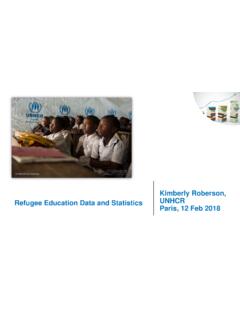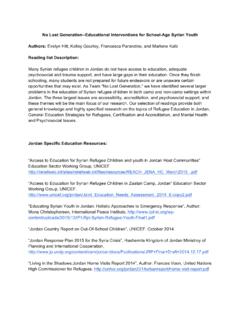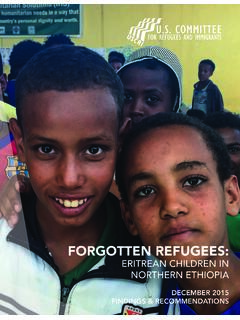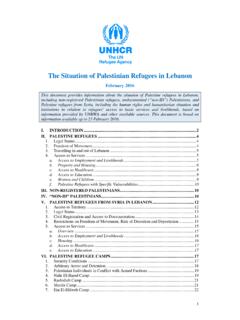Transcription of EDUCATION FOR REFUGEES - UNHCR
1 EDUCATION FOR REFUGEES Priority activities and requirements supporting enrolment and retention in 2016 10 August 2016 Cover photo: A young refugee from South Sudan at the Numanzi transit centre in Adjumani, northern Uganda. UNHCR /Will Swanson Maps in this document do not imply official endorsement or acceptance by the United Nations. Contents Introduction .. 1 Bangladesh .. 3 Cameroon .. 5 Chad .. 8 Djibouti .. 12 Egypt .. 15 17 Ghana .. 19 Kenya .. 21 Malawi .. 24 Malaysia .. 26 Nepal .. 28 Pakistan .. 29 Rwanda .. 32 Uganda .. 34 United Republic of Tanzania .. 37 40 1 Introduction EDUCATION is a basic human right, enshrined in both the 1951 Convention relating to the Status of REFUGEES and the 1989 Convention on the Rights of the Child.
2 And during times of displacement, EDUCATION plays an additional, crucial role in fostering social cohesion, addressing psychosocial needs, and providing a safe and stable environment for those who need it most. Yet globally it is estimated that only 50 per cent of refugee children of primary-school age are actually in school, a number that drops to 25 per cent for adolescent REFUGEES in secondary school. Indeed, refugee children and adolescents are five times more likely to be out of school than their non-refugee peers. Continued, sustainable access to quality EDUCATION thus remains a key concern for the roughly eight million REFUGEES under UNHCR s mandate who are under 18 years of age.
3 Compounding the challenge of addressing these vast needs are the diverse contexts in which they arise, from unfolding emergencies to protracted situations. Eighty-six per cent of all REFUGEES are hosted in developing countries, some of which are confronting institutional challenges in their EDUCATION systems and have limited capacity to support new populations. Behind global averages, there are significant differences among countries, but the fact remains: far too many REFUGEES are excluded from an EDUCATION , compromising the future of entire generations. Through its global 2012 2016 EDUCATION Strategy and country-level EDUCATION strategies, UNHCR supports the provision of refugee EDUCATION as a core element of its mandate to ensure protection and durable solutions for people of concern.
4 Partnering with governments and international and national non-governmental organizations, UNHCR seeks to integrate refugee learners within national systems wherever possible and appropriate. Focusing on 16 countries in Africa, Asia and the Middle East which collectively host million refugee children of school-age (5-17 years), an estimated 57 per cent of whom are out of school this document highlights targeted activities and requirements that could enable tens of thousands of refugee children to enrol in school during the upcoming academic year. These activities also seek to support retention of currently enrolled students; redress classroom over-crowding and a lack of qualified teachers; provide critical learning materials; and generally contribute to a safe and protective learning environment for all students.
5 In some instances, especially where REFUGEES are living in host communities, these activities will enhance the learning experience of host community students as well. 2 This information is drawn from UNHCR s 2016 budget, as presented in the 2016-2017 Global Appeal and subsequent supplemental appeals approved by the Executive Committee. The requirements outlined correspond to existing unfunded needs for activities which UNHCR could reasonably implement by the end of this year. Individual chapters provide an overview of the refugee and EDUCATION context in each of the 16 countries, followed by a description of critical challenges and proposed activities. The table that follows specifies remaining funding requirements for planned activities, providing relevant performance indicators, comparably 2015 year-end results (where applicable), and output targets for the activities by year-end 2016.
6 10 August 2016 3 Bangladesh For over 20 years, Bangladesh has hosted REFUGEES who fled Myanmar in the early 1990s. Currently, close to 32,000 registered REFUGEES -- 56 per cent of whom are children -- reside in Kutupalong and Nayapara refugee camps in Cox s Bazar district. Some 9,300 children are enrolled in 52 early childhood development centres, 21 primary and 2 secondary schools in the camps. Starting in 1996, registered refugee children were permitted to access non-formal educational services using the Myanmar curriculum. By 2007, the Government of Bangladesh, in collaboration with UNHCR , agreed to adopt the formal Bangladesh national curriculum for refugee children for grades 1 through 5, and the Government subsequently authorized the expansion of EDUCATION to post-primary levels grades 6 and 7.
7 4 While enrolment and attendance rates in primary and secondary EDUCATION in the camps have improved over time, more progress is needed: enrolment of school-aged children in primary EDUCATION is 82 per cent, while attendance is 78 per cent. The high rate of dropout remains a primary protection concern, with enrolment in secondary EDUCATION (grades 6 and 7) being only 11 per cent. Contributing factors include financial pressure for children to work and supplement household income; the low quality of EDUCATION and learning environment; restrictive cultural norms concerning adolescent girls; child marriage; and loss of hope for the future. In support of improved enrolment and attendance, UNHCR will continue to advocate for recognition of students EDUCATION achievements, including through formal certificates upon completion their studies.
8 UNHCR will also provide teaching materials, accelerated learning programmes to facilitate the re-assimilation children who have been out of school, and transportation allowances for vulnerable families. The quality of EDUCATION is greatly affected by the lack of qualified teachers: approximately 40 per cent of existing teachers are refugee volunteers who have not completed teacher training and received EDUCATION only to the grade 8 or 9 level. The challenging working environment, including low salaries, is another disincentive for highly-qualified Bangladeshi teachers. In response, UNHCR will focus on the recruitment of qualified teachers, including female teachers, as well as enhancing the capacity of existing teaching staff.
9 Population Activity Remaining requirements (US$) Performance indicator 2015 year-end results 2016 output target REFUGEES from Northern Rakhine State, Myanmar Primary EDUCATION : provision of school materials; teacher trainings; accelerated learning programmes; transportation allowances for vulnerable families 384,133 # of children enrolled in primary EDUCATION 7,046 7,800 Secondary EDUCATION : rehabilitation of classrooms; provision of school materials; teacher trainings; accelerated learning programmes; transportation allowances for vulnerable families 80,000 # of children enrolled in upper secondary EDUCATION 573 700 Bangladesh total 464,133 Cameroon Cameroon hosts the largest number of REFUGEES from the Central African Republic some 260,000.
10 The majority (more than 158,000) have only arrived since December 2013, while approximately 100,000 have been hosted in the country since 2003. In addition, Cameroon s far north has received an influx of over 65,000 Nigerian REFUGEES following escalating violence in Nigeria s Adamawa, Borno and Yobe states. Approximately 70 per cent of REFUGEES live in host communities, with the remainder in refugee sites located in the East, Adamawa and North regions. Specific EDUCATION strategies are being implemented for each refugee population group. Based on the 1951 Convention and other international treaties to which Cameroon is party, national law stipulates that REFUGEES have the right to EDUCATION , and, in principle, refugee children have the same access to schools as nationals.
